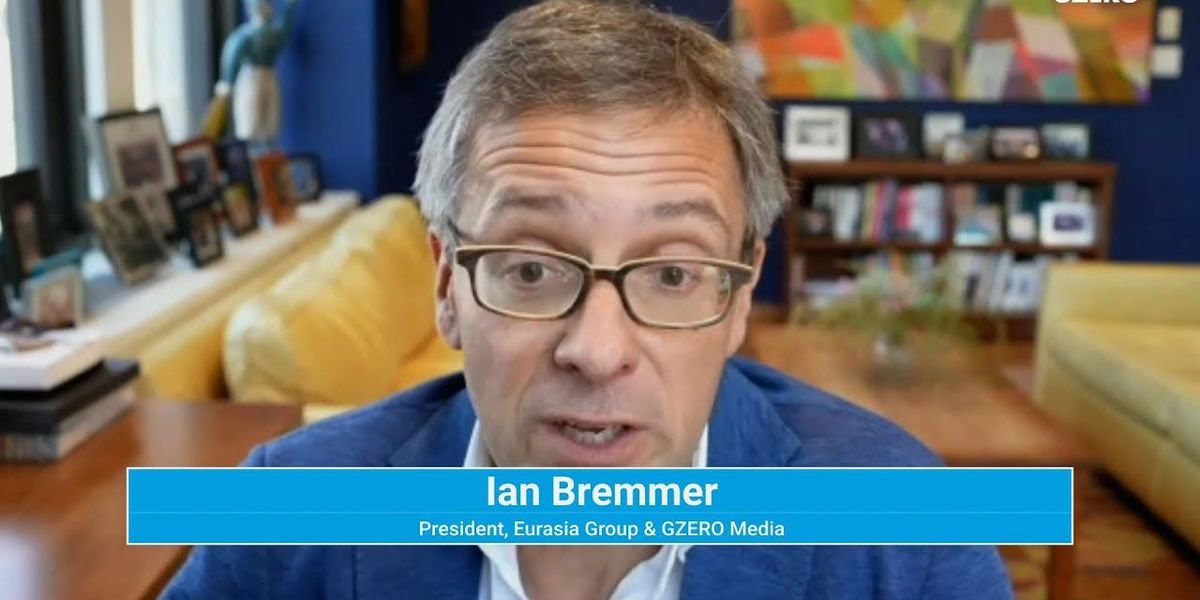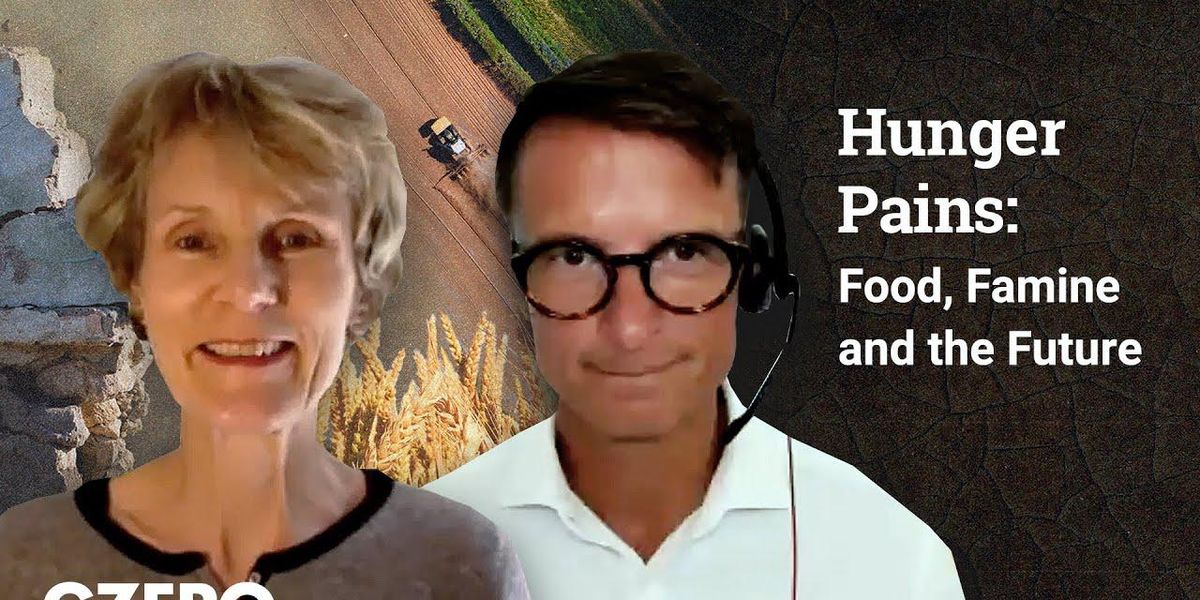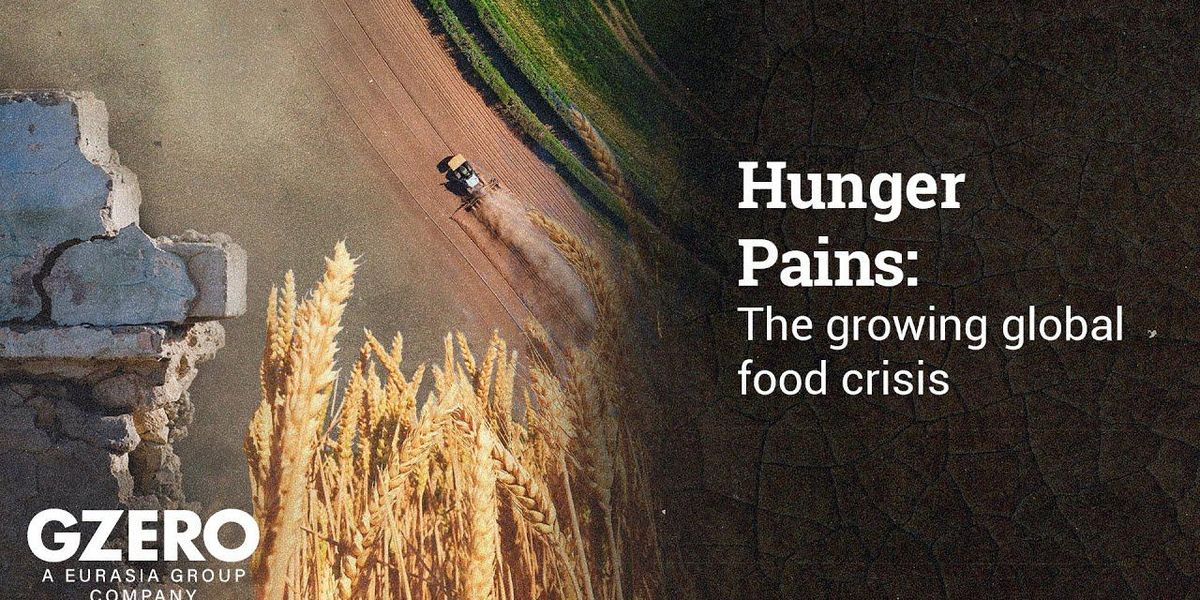Trending Now
We have updated our Privacy Policy and Terms of Use for Eurasia Group and its affiliates, including GZERO Media, to clarify the types of data we collect, how we collect it, how we use data and with whom we share data. By using our website you consent to our Terms and Conditions and Privacy Policy, including the transfer of your personal data to the United States from your country of residence, and our use of cookies described in our Cookie Policy.
{{ subpage.title }}
Episode 4: Broken (supply) chains
Listen: "Other than the impacts of the pandemic, which are easing, and from Russia/Ukraine, I'd say that the greatest risk to global supply chains today and moving forward will likely be from the US-China relationship, and the movement towards selective decoupling," says Jon Lang, Director for Trade and Supply Chains at Eurasia Group.
In the latest episode of Living Beyond Borders, a podcast produced in partnership between GZERO and Citi Global Wealth Investments, Lang is joined by Charlie Reinhard, Head of Investment Strategy for North America at Citi Global Wealth Investments, to discuss how global supply chains have largely adapted to and moved on from changes that occurred during the global pandemic.
While there are some impacts from the war in Ukraine and pent up demand, they also look at how tension between the US and China, as well as increasing regulation and calls for transparency, are changing the shape of supply chains as well as the economy as a whole.

Jon Lang
Director for Trade and Supply Chains, Eurasia Group

Charlie Reinhard
Head of Investment Strategy, North America, Citi Global Wealth Investments

Shari Friedman
Managing Director of Climate and Sustainability, Eurasia Group
- The Graphic Truth: The great supply chain squeeze ›
- Episode 7: Future-proofing: How we fix broken supply chains ›
- Episode 9: US/China power struggle, the global political balance, and your finances ›
- Episode 1: Should I STILL be worried? ›
- S3 Episode 9: US/China power struggle, the global political balance, and your finances - GZERO Media ›
- Episode 6: Can the US and China find common ground? - GZERO Media ›
- Episode 8: Global food (in)security - GZERO Media ›
- Episode 7: How AI is changing our economy - GZERO Media ›
- World trade at risk without globalization, warns WTO chief Ngozi Okonjo-Iweala - GZERO Media ›
Handout photo dated January 14, 2020 shows an MQ-9 Reaper flies over the Nevada Test and Training Range.
What We’re Watching: Drone drama, DeSantis vs. Ukraine, Japan hearts South Korea, Pakistan-Khan standoff
Drone drama over the Black Sea
In what is so far the closest thing to a direct clash between the US and Russia over Ukraine, a Russian jet on Tuesday crashed into an American drone over the Black Sea, sending the unmanned craft hurtling into the water.
Moscow disputes the claim, saying its jets didn't hit the drone. The US accused the pilots of two Russian Su-27s of being “unprofessional” and “environmentally unsafe” for harassing and “dumping fuel” on the $32 million MQ-9 Reaper drone.
But scholars point out that the US didn’t call the act “unlawful.” Russia was evidently within its rights to disrupt a drone in international territory that was almost certainly gathering intel for Moscow’s adversaries in Kyiv. Still, the incident shows the dangers of US and Russian military hardware operating in such close proximity, even if they aren’t in direct conflict.
Ron goes Don on Ukraine
Speaking of those dangers, Florida Gov. Ron DeSantis has waded into some foreign policy waters of his own, telling FOX News host Tucker Carlson he thinks that the Russia-Ukraine “territorial dispute” is not a vital US national interest and that Biden’s “blank check” for Kyiv is a distraction from more pressing issues like China.
This puts Desantis at odds with much of the GOP but firmly in line with … former President Donald Trump, whom he is all but sure to challenge for the Republican nomination in 2024.
Political wrangling aside, Desantis may be trying to catch a broader trend: In February, polls showed that only 48% of Americans favored providing weapons to Ukraine, down 12 points from May of last year. Is Ron on to something?
Japan and South Korea’s efforts to strengthen ties
South Korean President Yoon Suk Yeol and Japanese PM Fumio Kishida are meeting in Tokyo this week in a bid to forge stronger economic and security ties. Diplomatic engagement between the countries has stalled in recent years owing to territorial disputes and Japan’s rearmament amid what Koreans see as Japan’s efforts to whitewash World War II-era atrocities.
This follows a recent landmark agreement between Tokyo and Seoul for a South Korean fund to compensate victims of Japan’s forced labor camps during its 20th-century colonization of the Korean peninsula – a deal that has proven unpopular with South Koreans for not holding Japan directly and financially accountable.
Improved cooperation would help both countries meet the increasing security challenges posed by China and North Korea in the region. Restoring trade links between South Korea and Japan, meanwhile, will help alleviate high-tech global supply chains. But for this to work, Kishida’s government must first win over South Korean hearts and minds.
Imran Khan 1 - Pakistan’s government 0
Pakistani security forces on Wednesday withdrew from near Imran Khan’s home in Lahore after failing to detain the former PM, despite having an arrest warrant. The reason: to allow a big cricket match to take place in the city.
As the standoff unfolded, Khan — who used to captain the national team in cricket-crazy Pakistan — took to Twitter, urging his supporters not to give up. He was ousted in a no-confidence vote last April over allegations of corruption and “terrorism”, which he and his supporters dismiss as politically motivated. But since then, Khan has fervently sought to win back the top job, leading a populist movement against Pakistan’s political elite and all-powerful army, whom he accused of being behind an assassination attempt against him in Nov. 2022.
So far, the government was too scared of igniting his base to arrest the former PM, even after he was a no-show in court. Yet, in a country where the army calls many political shots, perhaps he’s made too many enemies. And if he’s behind bars when Pakistanis vote in provincial elections this fall, will his fans remain silent?
What We're Watching: Truckers wanted & not-so-cheap chips
Where are all the truck drivers?
The global truck driver shortage has been disrupting already-out-of-whack supply chains, particularly in the US, the European Union, and Britain – further complicating their post-pandemic economic recoveries. Last year, the American Truckers Association said it was around 80,000 drivers short, while in Europe, a deficit of 40,000 truckers has contributed to long waits and empty shelves.
What’s going on? The pandemic has upended the way we work. Trucking is an arduous and ungratifying gig: Drivers often spend days or weeks far away from home, and they don’t get paid for hours spent waiting for goods to be loaded and unloaded. The road can be grueling, the compensation is underwhelming, and the benefits are often … nonexistent. In the US, trucking salaries have plunged in recent decades. Median wages for truck drivers in 1980 were about $110,000 annually (adjusted for inflation); in 2020, they were just $47,130. Unsurprisingly, many truckers are opting for jobs with better conditions and pay, so trucking firms in Europe and the US are struggling to lure drivers back to work and recruit new staff. It’s particularly grim in the UK, where supply side frictions have been exacerbated by Brexit. In the US, meanwhile, companies like Walmart are fighting back by offering massive salary hikes to attract truck drivers. Will it get the wheels turning?
Chipping away at supply chains
The US Congress this week passed the behemoth CHIPS and Science Act, which ponies up $52 billion in subsidies and incentives to boost domestic production of semiconductors, the invisibly thin microchips that are essential for everything from phones, cars, and factories, to fighter jets, cruise missiles, and artificial intelligence. With the bill, Congress is making a big move in a new global “Chips race” for dominance of the industry: the EU is now spending close to $50 billion on the same thing, and China, which still depends on the US and its allies for inputs into its home-grown chips, has poured hundreds of billions into some day becoming a semiconductor superpower itself. For all three of the world’s largest economies the concern is the same: the semiconductor market is highly concentrated, particularly in Taiwan, which produces more than 60% of the world’s chips. That’s a problem commercially – in 2021, there was a global shortage after tech firms gobbled up the entire supply, leaving automakers scrambling for chips. But it’s also a problem geopolitically. China doesn’t want to be dependent on chips from a Taiwan that’s allied with the US, while the US and EU don’t want to rely on a Taiwan that could be taken over by China any year now. Critics of the US CHIPs act say its a sop to powerful tech companies that can well afford to build their own factories, and there are questions about whether the money will be spent on the right things: making the chips is one thing, cutting edge R&D is a whole other bowl of chips, and the supply chain for a single chip can pass through many countries before final assembly. As a cautionary tale: the EU aimed in 2013 to double its share of global semiconductor production to 20% by 2020. It didn’t work.
The Graphic Truth: The great supply chain squeeze
The pandemic sent global supply chains into a tizzy. Then, just as economies were embarking on their post-COVID economic recoveries, Russia invaded Ukraine, upending the global grain trade and sending supply chains spiraling further. Supply chain frictions have a lot of unintended consequences: Brexit-related supply chain issues made it hard for some Brits to get their hands on a pint of beer, while China’s punitive zero-COVID policy drove the auto industry – among others – into a full-blown crisis. We take a look at the Global Supply Chain Index from 2000-2022 along with key global economic milestones.
Ian Bremmer: Global middle class erosion making people hungrier — and angrier
Until recently, global development had been defined by globalization, especially when it comes to a growing middle class and poverty reduction.
Not anymore, Eurasia Group President Ian Bremmer said during a livestream conversation about the global food crisis hosted by GZERO Media in partnership with the Bill & Melinda Gates Foundation.
The global middle class is eroding due to multiple crises now aggravated by food shortages and price hikes related to Russia's war in Ukraine. And that, he added, is having a direct impact on our state of mind.
People are becoming hungrier and angrier, Bremmer explained, and they will become less interested in global solutions to their problems — a sentiment that, in turn, will be reflected in their choice of government.
- Global food crisis: when food isn't merely expensive - GZERO Media ›
- The politics of resentment & how authoritarian strongmen gain ... ›
- Podcast: How discontent with globalization has fueled authoritarian ... ›
- End of globalization for Russia - GZERO Media ›
- State of the World: On the verge of fragmentation? - GZERO Media ›
- How globalization backfired - GZERO Media ›
Why we're in the current food crisis — and who could fix it
Sylvain Charlebois knows a thing or two about food. He's a professor at Dalhousie University in Halifax, Canada, and tweets as @FoodProfessor. So, what does he think about the current global food crisis?
It started two years ago, when COVID disrupted supply chains, but the acute shortages that are driving up prices are more recent, he explained in a conversation for GZERO with Diana Fox Carney, Senior Advisor at Eurasia Group.
Why? Charlebois cites climate issues that hurt inventories, higher shipping costs due to the COVID hangover of weakened supply chains, Russia's war in Ukraine pushing prices up across the board, and "nationalistic hoarding" of staples by certain countries.
And it's going to get worse, especially in North Africa and the Middle East. So, what, if anything, can we do about it?
For Charlebois, the geopolitical wildcard is China, the only country with enough influence to change everything in a matter of weeks. The US could do more too, but in his view there's just too much politics for America to move on anything quickly.
Food prices, he predicts, will continue to rise for quite some time, because if this were an ice hockey match, we're probably only at the end of the first period.
For more, check out Hunger Pains, GZERO Media's special coverage of the world’s growing food crisis.
- Exports controls are "worst possible" thing to do in a food crisis, says UN Foundation chief - GZERO Media ›
- In a food crisis, export controls are "worst possible" thing to do, says UN Foundation chief - GZERO Media ›
- What's causing the growing global food crisis? Live townhall today at 2 pm ET - GZERO Media ›
- What's causing the global food crisis? Live townhall today at 2 pm ET - GZERO Media ›
- Global food crisis: when food isn't merely expensive - GZERO Media ›
- Food emergency: what to do when people are hungry now - GZERO Media ›
Introducing GZERO's coverage on Hunger Pains: the growing global food crisis
The world is on the brink of a crisis that could push more than a billion people towards starvation. A crisis that could upend governments, roil global markets, and rattle households around the world.
The pandemic has scrambled food supply chains, raising costs for everyone. Droughts and floods tied to climate change have hampered harvests around the world. And Russia’s war with Ukraine has made it all worse.
Today, the world faces the sharpest “hunger pains” since the end of World War 2.
GZERO Media’s special coverage of the ongoing food crisis takes you deeper into the story.
For some, the crisis will mean higher prices, empty shelves, or shuttered businesses. But for hundreds of millions of others, it will be a matter of life and death.
How can the world cope? What are governments doing to make things better, or worse? And how will it all affect YOU?
Follow our coverage at gzeromedia.com/hunger-pains to find out.Models of oil barrels and a pump jack are displayed in front of a rising stock graph
What We're Watching: Soaring oil prices, inching towards an Iran nuclear deal
Rising energy crisis? Barely a week after Russia’s invasion of Ukraine, energy prices are going up faster than most experts predicted. Brent oil rose above $119 a barrel on Thursday, while Dutch natural gas futures — the benchmark for Europe — were trading at the equivalent of $360 per crude barrel. What’s more, prices are already soaring before Western sanctions have targeted Russian oil and gas, which could provoke Moscow into cutting off supplies to Europe. Why is this happening? Demand for Russian commodities has plummeted over fears that the next wave of sanctions will include energy. This week, the US and 30 other countries announced the release of 60 million barrels of oil from their strategic reserves to stop the bleeding, but that won’t be enough if the Russians turn off the tap. Will the Europeans continue supporting tough sanctions when their citizens start complaining about the cost of electricity bills and gas at the pump?
Is the Iran nuke deal being revived? The 2015 nuclear deal with Tehran could reportedly be revived within the coming days or weeks. The head of the International Atomic Energy Agency plans to visit Tehran on Saturday to try to iron out a couple points of contention and shore up support for the accord, which would give Iran sanctions relief — likely including lifting bans on its oil exports — in exchange for Tehran hitting the brakes on its nuclear program. But critics say that the Biden administration’s push to return to the terms of the 2015 deal is misguided because Iran’s nuclear program is now significantly more advanced. Since the US abandoned the deal in 2018, Tehran has been upping its uranium enrichment game, a claim supported by the Vienna-based IAEA, which said Thursday that Iran is close to having enough material to make an atomic bomb. Meanwhile, a former US State Department official tweeted Wednesday that the US was preparing to lift sanctions on the powerful Islamic Revolutionary Guards Corps as well as on the supreme leader's office, though those claims have not been corroborated.


